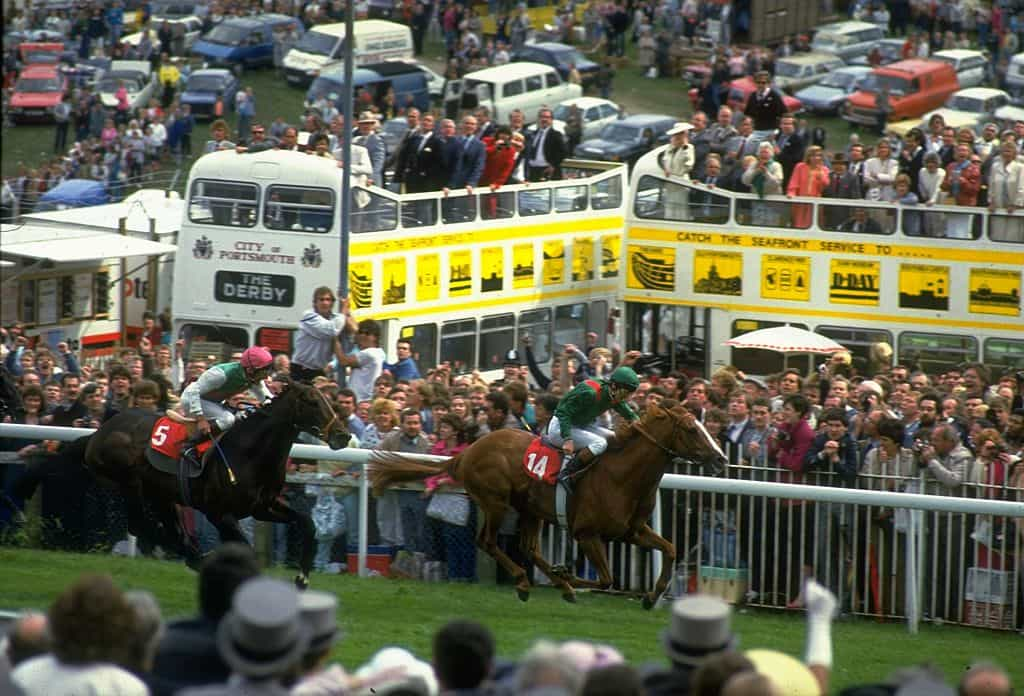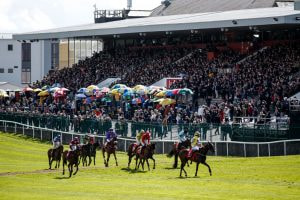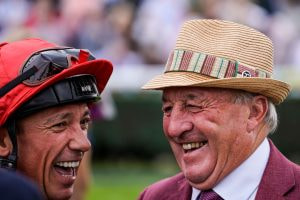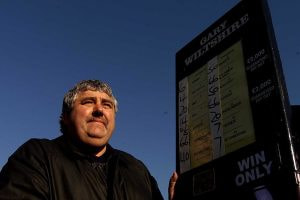Epsom Derby Winners – Who Was the Greatest and Why?
The Epsom Derby is the original Derby. First run in 1780 and named after the British peer and politician Edward Smith-Stanley, 12th ‘Earl of Derby’, it outdates the Kentucky Derby by 95 years. Remarkably, Epsom Racecourse had already been racing for 119 years before Diomed became the first winner of the Epsom Derby.
Traditionally, the Epsom Derby took place on the first Wednesday in June. Such was the popularity of the race, Derby Day was considered an unofficial public holiday from the mid-1800s. Tackling dwindling attendance, and to increase betting turnover and its television audiences, authorities switched the race day to the first Saturday in June from 1995.

Shahrastani repelled the fast finishing Dancing Brave to win the controversial 1986 Epsom Derby. ©GettyImages
Place Players Can Be Epsom Derby Winners
In 1862 a record 34 runners went to post for the Epsom Derby. The Derby now has a maximum field size of 20. In the modern era, the famous race usually features 12 or more runners and is covered by £5 minimum deposit betting sites. This allows for enhanced each-way betting terms, and this has been a fantastic race for big-priced placed horses.
The 2022 Epsom Derby winner, Desert Crown, started as the 5/2 favorite. But the forecast spot was filled by a 150/1 shot, Hoo Ya Mal. Similarly, the 2010 runner-up, At First Sight, was a 100/1 poke. Dragon Dancer, a rare Derby runner that entered the race as a maiden, finished second at Epsom Derby betting odds of 66/1 in 2006.
But the list of Epsom Derby winners and placed horses features an even bigger priced outsider that rewarded his each-way backers. In 1989, Terimon finished second at the incredible odds of 500/1.
Big Derby Odds but Small Careers
In recent years Aidan O’Brien has provided some massive-priced Epsom Derby winners. 2017 victor, Wings of Eagles scored at odds of 40/1. Serpentine, the all-the-way five-length Epsom Derby winner from 2020, was a 25/1 scorer for the Irish trainer.
However, Wings of Eagles only ran once more and now stands at stud for a relatively minuscule €3,500 stud fee. Serpentine’s career went downhill rapidly. Tried at trips from a mile to two miles and four furlongs, the son of Galileo never won again. Gelded two years after etching his name on the Epsom Derby winner list, Serpentine was exported to race in Australia in 2022.
Epsom Derby Winners List
| Year | Winner | Jockey | Trainer | Odds |
|---|---|---|---|---|
| 2021 | Adayar | Adam Kirby | Charlie Appleby | 16/1 |
| 2020 | Serpentine | Emmet McNamara | Aidan O’Brien | 25/1 |
| 2019 | Anthony Van Dyck | Seamie Heffernan | Aidan O’Brien | 13/2 |
| 2018 | Masar | William Buick | Charlie Appleby | 16/1 |
| 2017 | Wings Of Eagles | Paddy Beggy | Aidan O’Brien | 40/1 |
| 2016 | Harzand | Pat Smullen | John Oxx | 13/2 |
| 2015 | Golden Horn | Frankie Dettori | John Gosden | 13/8 Fav |
| 2014 | Australia | Joseph O’Brien | Aidan O’Brien | 11/8 Fav |
| 2013 | Ruler Of The World | Ryan Moore | Aidan O’Brien | 7/1 |
| 2012 | Camelot | Joseph O’Brien | Aidan O’Brien | 8/13 Fav |
| 2011 | Pour Moi | Mickael Barzalona | Andre Fabre | 4/1 |
| 2010 | Workforce | Ryan Moore | M Stoute | 6/1 |
| 2009 | Sea The Stars | Mick Kinane | John Oxx | 11/4 |
| 2008 | New Approach | Johnny Murtagh | Jim Bolger | 5/1 |
| 2007 | Authorized | Frankie Dettori | Peter Chapple-Hyam | 5/4 |
| 2006 | Sir Percy | Martin Dwyer | Marcus Tregonig | 6/1 |
Derby Folklore and a Titanic Winner
Of course, the list of Epsom Derby winners features some of horse racing’s all-time greats. And there are fascinating historical stories surrounding many Epsom Derby winners. The disappearance of Shergar, the ten-length Derby winner in 1981, is one such tale. It is now weaved into folklore.
Epsom Derby fact: The 1931 Derby featured the first remote outside television broadcast in the world. pic.twitter.com/TwYp2pfOLr
— Sports & Betting History by BestBettingSites (@CDCHistory) November 25, 2020
1913 was another historically important year for the Derby. The 6/4 favorite, Craganour, owned by Charles B. Ismay – the brother of Joseph Ismay, the chairman and managing director of White Star Line who survived the Titanic’s sinking – past the line ahead but was controversially disqualified, and the race was awarded to the 100/1 outsider, Aboyeur.
In the same race, before an estimated 500,000 racegoers, suffragette Emily Davison was struck by King George V’s horse, Anmer. She died from her injuries four days later. As a result, the 1913 Epsom Derby is often referred to as ‘The Suffragette Derby’.
Epsom Derby Winners in Popular Culture
Forty years later, for the first and only time, Sir Gordon Richards became an Epsom Derby-winning jockey on his 28th attempt when Pinza won the race by four lengths. Success in horse racing’s blue riband event was never a problem for Lester Piggott. The legend partnered with nine Epsom Derby winners between 1954 and 1983.
Several Derby runners have later become stars over jumps. Sea Pigeon, who finished seventh to 1973 Epsom Derby winner Morston, went on to win two Champion Hurdles. And Lester Piggott, who finished 15th on Prince Charlemagne in the 1953 Derby, rode the same horse to victory in the Triumph Hurdle nine months later.
Four feature films have centered around the Epsom Derby: 1937s Wings of the Morning; 1948s Esther Waters; 1952s Derby Day and the 1956 comedy, The March Hare. More recently, in 2014, Peaky Blinders series two concluded with scenes set at a 1920s Epsom Derby.
Brave Danced All Over His Rivals
Before looking at the finest Epsom Derby winners of all time, it would only be fair to reflect on the career of one of its most famous losers – Dancing Brave, the runner-up in 1986.
With a horseshoe-shaped circuit that immediately rises 134 feet and then roller coasters around Tattenham Corner leading into a cambered straight where there is a 50-feet drop until 100 yards from home where the ground rises again, the quirky Epsom Racecourse would appear designed for hard-luck stories.
But, holding Dancing Brave up in last with three furlongs to run in a race that had been contested at a slow tempo was not the finest strategic call since Ali beat Foreman by inventing the rope-a-dope technique in 1974.
Desperately unlucky not to join the list of Epsom Derby winners following a whirlwind finish, Dancing Brave would show the Epsom form to be all wrong by winning the Eclipse Stakes. The scalp of Epsom Derby winner, Shahrastani, was then taken in the King George VI and Queen Elizabeth Stakes at Ascot.
Dancing Brave finished his European three-year-old career by winning the Select Stakes at Goodwood and spreadeagling one of the finest Arc de Triomphe fields ever assembled in track record time.
Who Was the Greatest Epsom Derby Winner?
So, who was the best winner of the Epsom Derby? Despite winning the 1971 Derby by two lengths and then taking the Eclipse, King George VI and Queen Elizabeth Stakes and Prix de l’Arc Triomphe, Mill Reef rarely appears on the lists of the greatest Epsom Derby winners.
Visually, the effortless victory of the 1965 Epsom Derby winner, Sea Bird, ranks highly. And Shergar’s impressive romp was almost matched by Slip Anchor in 1985. Under Steve Cauthen Henry Cecil’s charge won by seven lengths. It is a winning margin that has not been bettered since.
Seven lengths is a theme with great Epsom Derby winners. The 1979 Derby winner, Troy, came from off the pace to win the race by the same margin. The exceptional middle-distance racehorse trained by Dick Hern (the winner of three Epsom Derbies) also won the Irish Derby, the King George VI and Queen Elizabeth Stakes, and the Benson and Hedges Gold Cup – now known as the Juddmonte International.
The Crown Belongs to Nijinsky
In 2011, Workforce also won the classic by seven lengths. In doing so, Workforce became the fastest-ever winner of the Derby. Sir Michael Stoute’s horse stopped the clock at 2:31.33 seconds.
But, our idea of the greatest-ever winner of the Epsom Derby is 1970 scorer, Nijinsky. Trained in Ireland by Vincent O’Brien and ridden by Lester Piggott, the Canadian-bred racehorse won the Epsom Derby courtesy of a trademark cool and confident Piggott ride.
Already winner of the 2000 Guineas, Nijinsky would go on to win the Irish Derby, the King George VI and Queen Elizabeth Stakes and then become the first Triple Crown winner in 35 years by taking the St Leger. No colt has won the Triple Crown since.



